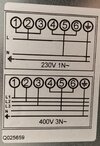- Joined
- 7 Mar 2004
- Messages
- 298
- Reaction score
- 4
- Country

Hi,
My property has a 3-phase CU and my new range cooker appears to offer the option of being wired as single or 3-phase (connection diagram attached). The electricians have installed two cables aiming to share the load for a single phase appliance (they didn't know the cooker would be capable of being wired for 3-phase). My (Schneider) CU uses RCBOs for each circuit so I'm guessing it's going to be expensive for a 3P RCBO...
1. Are there any advantages to having it wired as 3-phase? I thought it might be the case that I use everything all at once on full power (however unlikely)
2. What happens if one phase fails? I'm in a rural area so when there's the odd power cut, it usually affects just one phase.
Thanks
My property has a 3-phase CU and my new range cooker appears to offer the option of being wired as single or 3-phase (connection diagram attached). The electricians have installed two cables aiming to share the load for a single phase appliance (they didn't know the cooker would be capable of being wired for 3-phase). My (Schneider) CU uses RCBOs for each circuit so I'm guessing it's going to be expensive for a 3P RCBO...
1. Are there any advantages to having it wired as 3-phase? I thought it might be the case that I use everything all at once on full power (however unlikely)
2. What happens if one phase fails? I'm in a rural area so when there's the odd power cut, it usually affects just one phase.
Thanks


